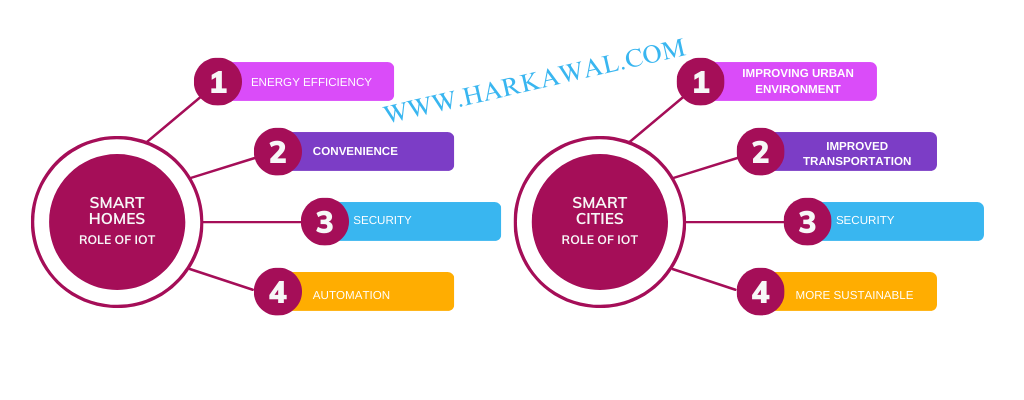The Role of IoT in Smart Homes and Cities
The Internet of Things (IoT) is transforming the way we live our lives, and nowhere is this more apparent than in the realm of smart homes and cities. IoT-enabled devices are becoming increasingly popular, and they are helping to make our homes and cities more efficient, sustainable, and connected than ever before. In this blog post, we will explore the role of IoT in smart homes and cities, and how it is shaping the future of urban living.
What is IoT?
Before we dive into the role of IoT in smart homes and cities, let’s first define what IoT is. IoT refers to the network of physical devices, vehicles, home appliances, and other objects that are embedded with sensors, software, and connectivity, enabling them to collect and exchange data. These devices can communicate with each other, and with humans, creating a vast web of interconnected devices that can be used to improve our lives in countless ways.

Smart Homes
IoT is transforming our homes into smart homes, where everything from our doorbells to our thermostats can be connected and controlled from a single device. Smart home devices can monitor our energy usage, adjust our heating and cooling systems, and even order groceries on our behalf. They can also improve our security, allowing us to monitor our homes from anywhere in the world using our smartphones.
As the world continues to evolve, the use of IoT in homes is becoming increasingly popular. Smart homes not only provide convenience, but they can also have a positive impact on the environment. By monitoring energy usage, smart devices can help homeowners save on their energy bills while reducing their carbon footprint.
In addition to energy efficiency, smart home devices can also enhance safety and security. For instance, smart locks can be programmed to only allow authorized individuals access to a home, while security cameras can provide homeowners with a real-time view of their property from anywhere in the world.
Another benefit of smart homes is the ability to automate routine tasks, such as ordering groceries or turning off lights. This can save homeowners time and allow them to focus on more important tasks.
Overall, it is clear that IoT is transforming the way we interact with our homes. The possibilities are endless, and as technology continues to advance, we can expect even more innovative solutions to improve our daily lives.
Smart Cities
IoT is also transforming our cities into smart cities. Cities around the world are using IoT to create more efficient and sustainable urban environments. IoT-enabled sensors can monitor everything from traffic patterns to air quality, allowing city planners to make data-driven decisions to improve the quality of life for their citizens. Smart cities are also more connected, with high-speed internet and 5G networks enabling faster and more reliable communication between devices and people.
In addition to improving urban environments, the implementation of IoT in smart cities has also led to increased safety and security. For example, smart cameras and sensors can monitor public spaces and alert authorities in case of emergencies. This has helped reduce crime rates in some cities and has made citizens feel safer when out and about.
Another benefit of IoT-enabled smart cities is improved transportation systems. Real-time data captured by sensors can help optimize traffic flow and reduce congestion. This not only saves time for commuters but also reduces air pollution caused by idling vehicles. Additionally, IoT can help improve public transportation systems, making them more efficient and reliable.
Smart cities are also becoming more sustainable with the help of IoT. Sensors can monitor energy usage in buildings and public spaces, allowing city planners to identify areas for improvement and reduce carbon emissions. IoT can also help with waste management by monitoring trash levels, optimizing collection routes, and reducing the amount of waste sent to landfills.
Overall, IoT is revolutionizing the way we think about and interact with our cities. The possibilities for improving the quality of life for citizens are endless with the implementation of smart city technology.
The Future of IoT in Smart Homes and Cities
As IoT continues to evolve, we can expect to see even more innovative applications in smart homes and cities. We may see autonomous vehicles and drones delivering goods and services, and smart homes that can anticipate our needs before we even know we have them. Cities may become more resilient to natural disasters, with IoT-enabled sensors detecting earthquakes, hurricanes, and floods in real-time, and responding accordingly.
With the continued evolution of IoT, the possibilities for innovative applications are endless. Here are some additional ways in which IoT can transform our daily lives:
Personalized healthcare: IoT devices can monitor our health in real-time, alerting us and healthcare professionals to potential health issues before they become serious.
Energy efficiency: Smart homes can adjust energy usage based on occupancy and weather, leading to significant energy savings and reduced carbon footprint.
Improved public safety: Real-time monitoring of traffic and crime patterns can help law enforcement to respond quickly to emergencies and prevent crimes before they occur.
Enhanced agriculture: IoT sensors can monitor soil moisture, nutrient levels, and weather patterns to help farmers optimize crop yields and reduce water usage.
As we move forward, it will be exciting to see how IoT continues to shape the world around us and improve our quality of life.
Conclusion
The role of IoT in smart homes and cities is rapidly evolving, and the possibilities are endless. IoT-enabled devices are transforming our homes and cities into more efficient, sustainable, and connected environments. As we continue to explore the potential of IoT, we can expect to see even more exciting applications in the years to come.